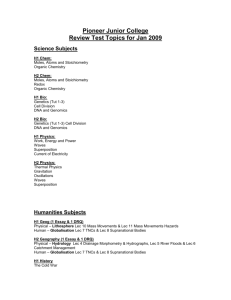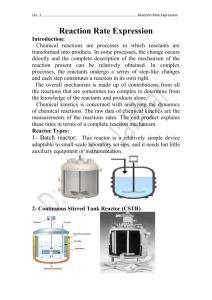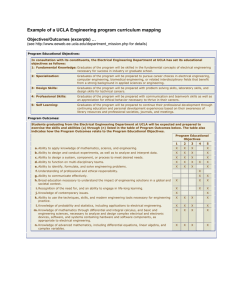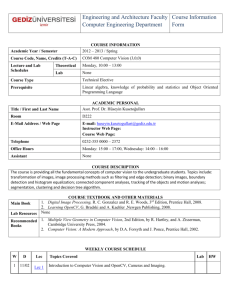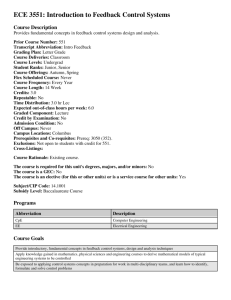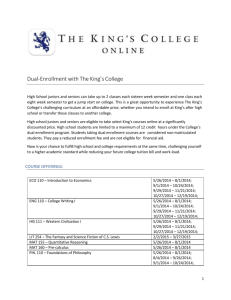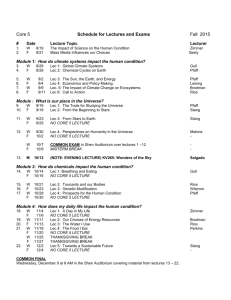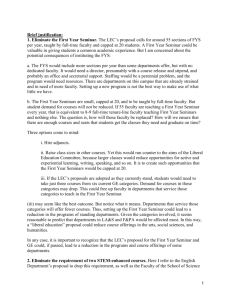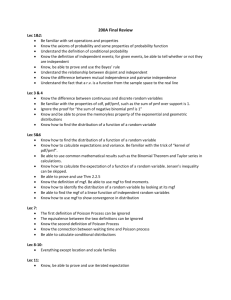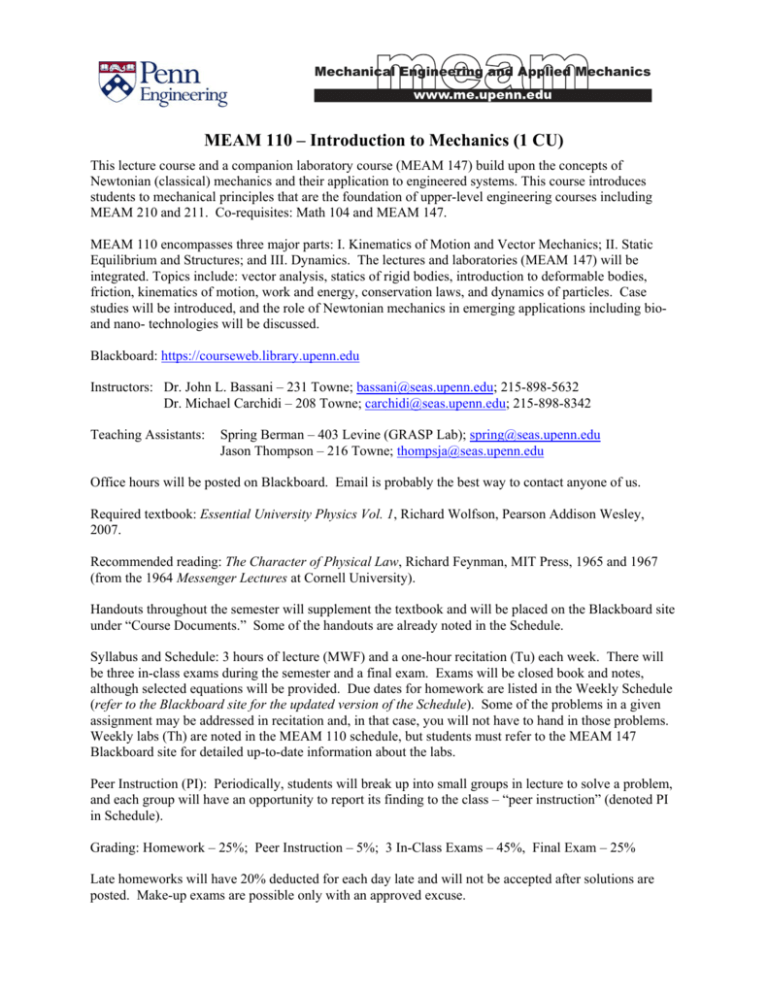
meam
Mechanical Engineering and Applied Mechanics
MEAM 110 – Introduction to Mechanics (1 CU)
This lecture course and a companion laboratory course (MEAM 147) build upon the concepts of
Newtonian (classical) mechanics and their application to engineered systems. This course introduces
students to mechanical principles that are the foundation of upper-level engineering courses including
MEAM 210 and 211. Co-requisites: Math 104 and MEAM 147.
MEAM 110 encompasses three major parts: I. Kinematics of Motion and Vector Mechanics; II. Static
Equilibrium and Structures; and III. Dynamics. The lectures and laboratories (MEAM 147) will be
integrated. Topics include: vector analysis, statics of rigid bodies, introduction to deformable bodies,
friction, kinematics of motion, work and energy, conservation laws, and dynamics of particles. Case
studies will be introduced, and the role of Newtonian mechanics in emerging applications including bioand nano- technologies will be discussed.
Blackboard: https://courseweb.library.upenn.edu
Instructors: Dr. John L. Bassani – 231 Towne; bassani@seas.upenn.edu; 215-898-5632
Dr. Michael Carchidi – 208 Towne; carchidi@seas.upenn.edu; 215-898-8342
Teaching Assistants:
Spring Berman – 403 Levine (GRASP Lab); spring@seas.upenn.edu
Jason Thompson – 216 Towne; thompsja@seas.upenn.edu
Office hours will be posted on Blackboard. Email is probably the best way to contact anyone of us.
Required textbook: Essential University Physics Vol. 1, Richard Wolfson, Pearson Addison Wesley,
2007.
Recommended reading: The Character of Physical Law, Richard Feynman, MIT Press, 1965 and 1967
(from the 1964 Messenger Lectures at Cornell University).
Handouts throughout the semester will supplement the textbook and will be placed on the Blackboard site
under “Course Documents.” Some of the handouts are already noted in the Schedule.
Syllabus and Schedule: 3 hours of lecture (MWF) and a one-hour recitation (Tu) each week. There will
be three in-class exams during the semester and a final exam. Exams will be closed book and notes,
although selected equations will be provided. Due dates for homework are listed in the Weekly Schedule
(refer to the Blackboard site for the updated version of the Schedule). Some of the problems in a given
assignment may be addressed in recitation and, in that case, you will not have to hand in those problems.
Weekly labs (Th) are noted in the MEAM 110 schedule, but students must refer to the MEAM 147
Blackboard site for detailed up-to-date information about the labs.
Peer Instruction (PI): Periodically, students will break up into small groups in lecture to solve a problem,
and each group will have an opportunity to report its finding to the class – “peer instruction” (denoted PI
in Schedule).
Grading: Homework – 25%; Peer Instruction – 5%; 3 In-Class Exams – 45%, Final Exam – 25%
Late homeworks will have 20% deducted for each day late and will not be accepted after solutions are
posted. Make-up exams are possible only with an approved excuse.
MEAM 110 Syllabus and Weekly Schedule (updated Nov. 7)
Week
1
2
3
4
Date
9/5 (Lec)
CD
Introduction to mechanics (W – Ch. 1);
Gravitation (W – Sec. 8.1, 8.2, 8.5; F – Ch. 1)
9/6 (Lab)
Introduction
9/7 (Lec)
Overview of math requirements: some vector
algebra, trigonometry, and a little calculus; Maple
and Matlab are useful but not required;
Units, accuracy, estimation; IDEA strategy of
problem solvingCD (F – Ch. 2); Safe design
9/10 (Lec)
Motion in a straight line: displacement, time,
velocity and acceleration (W – Ch. 2)
9/11 (Rec)
Unit conversion, average speed, radius of the
earth - see recitation problems on Blackboard
9/12 (Lec)
Constant acceleration (1D), e.g. tossing a ball
vertically; Preview of energy conservation
(handoutCD); Matlab simulationCD; PI-1: dropping
versus tossing‡
9/13 (Lab)
One-dimensional motion
9/14 (Lec)
Motion in 2D and 3 D; Vectors (W – Ch. 3)
9/17 (Lec)
Vectors, coordinate systems, components of
vectorsCD; Constant acceleration (2D)
9/18 (Rec)
One and two-dimensional motion with uniform
acceleration - recitation problems on Blackboard
9/19 (Lec)
2D Projectile motions; Matlab simulationCD ; PI2: optimum launch angle
9/20 (Lab)
Manufacturing and metrology
9/21 (Lec)
Forces and motion; Newton’s 1st and 2nd Laws
and equations of motion; Inertial and non-inertial
frames of reference (handoutCD) (W – Ch. 4)
9/24 (Lec)
Circular motion (handoutCD); Newton’s 3rd law;
Atwood’s machine (handoutCD)
9/25 (Rec)
Relative motion - see recitation problems on
Blackboard
9/26 (Lec)
Harmonic oscillations (handoutCD): spring-mass
system (W – Sec. 13.1, 13.2); Inertial effects and
when they are negligible
9/27 (Lab)
Force and motion
9/28 (Lec)
*
*
Topic ( Chapter or Section )
Homework
Due
†
Ch. 1: 17, 20, 23, 41 , 48
9/12
Ch. 8: 12, 16 (μ =10 )
-6
Ch. 2: 20, 22, 23, 24, 28,
36, 41, 52, 73
9/19
Ch. 3: 17, 21, 31, 34, 42,
45, 60, 73, 78
9/26
Ch. 4: 32, 45, 47, 51, 55,
69
10/3
Static equilibrium (W – Ch. 12); Free-body
diagrams and problem solving strategies
(handoutCD); PI-3: squashing a cockroach
W=Wolfson and F=Feynman. Note: (a) Chapters and sections are only listed on the day of the first lecture that
the topics arise. (b) Unless specific sections are listed, you should read the entire chapter.
CD
Denotes “Course Document” on Blackboard. Documents handed out in class are also noted.
†
At standard temperature and pressure, one “mole of air” contains Avogadro’s number of molecules, about
6.02x1023, and occupies a volume of 22.4 liters.
‡
Peer instruction – Students will break up into small groups and discuss the solution to a problem posed in class.
Problems and solutions on Blackboard.
5
6
7
10/1 (Lec)
Static equilibrium and stability (W – Ex. 5.2 and
5.3, pp. 69 and 70; Ch. 12)
10/2 (Rec)
Newton’s laws of motion – see recitation
problems on blackboard
10/3 (Lec)
Rotational motion and moments (handoutCD);
Systems of forces and moments acting on bodies
– we will primarily consider 2D systems; Snapthrough buckling (handoutCD)
10/4 (Lab)
Force equilibrium and translational stability:
Snap through buckling
10/5 (Lec)
Exam 1
10/8 (Lec)
Moments (torques): Secs. (10.2 and 11.2; Ch. 12)
10/9 (Rec)
Newton’s laws of motion and circular motion –
see recitation problems on blackboard
10/10 (Lec)
More on static equilibrium; Moment-induced
buckling (handout)
10/11 (Lab)
Moment equilibrium and rotational stability:
Tipping and Moment-Induced Buckling
10/12 (Lec)
Moments peddling a bicycle (handoutCD); PI 4:
Hanging a sign
10/15 (Lec)
Fall Break
10/16 (Rec)
Fall Break
10/17 (Lec)
10
Ch. 12: 31, 33, 37, 56,
problem on buckling
(see Blackboard)
10/24
Ch. 6: 14, 15, 20
10/24
Ch. 6: 28, 33, 44, 54, 63,
74, 81; Ch. 7: 21, 24
10/31
Stress and strain: Hooke’s law
10/19 (Lec)
Work (W – Ch. 6)
10/22 (Lec)
Work, energy and power
10/23 (Rec)
Forces and Circular Motion
10/24 (Lec)
Conservation of energy (W – Ch. 7; F – Ch. 3)
10/25 (Lab)
9
10/12
Introduction to axial stress and strain; Hooke’s
law (handout)
10/18 (Lab)
8
Ch. 12: 21, 24, 28, 29
Interaction forces at a distance:
Model AFM Lab
10/26 (Lec)
Conservation of energy: minimum potential
energy (handout). PI 5: Climbing a ladder.
Ch. 7: 28, 39, 45, 58, 59,
62
11/7
10/29 (Lec)
Friction, Tribology, Adhesion (W – 5.4, 5.5)
(handoutCD)
Ch. 5: 29; Ch. 12: 39
11/7
10/30 (Rec)
Forces and Moments
10/31 (Lec)
Review
Ch. 9: 18, 24, 27, 31, 32,
37, 42, 56
11/16
11/1 (Lab)
Static and kinetic friction
11/2 (Lec)
Exam 2
11/5 (Lec)
More on conservation of energy, e.g. pendulum,
pin ball. Bouncing ball.
11/6 (Rec)
Friction and Energy Methods
11/7 (Lec)
Energy loss (dissipation) due to friction: nonconservative forces. PI 6: Skateboarding bowl.
11/8 (Lab)
Ballistic Motion and Energy
11
12
11/9 (Lec)
Dynamics: systems of particles; center of mass
(W – Ch. 9).
11/12 (Lec)
Internal and external forces; Conservation of
momentum of system when net external force
vanishes.
11/13 (Rec)
Impulse Force and Center of Mass
11/14 (Lec)
Recoil – e.g. shooting a gun; Collisions in 1D
and coefficient of restitution; Impulse forces.
(W – Sec. 9.4 – 9.6)
11/15 (Lab)
Energy, Momentum and Coefficient of Restitution
11/16 (Lec)
Kinetic energy for collisions in 1D and
coefficient of restitution; Crash safety.
Ch. 9: 62, 66, 71, 78
11/28
11/19 (Lec)
Collisions in 2D; Rotational motion: angular
velocity and acceleration; Moments (torques),
rotational inertia, and rotational analog of
Newton’s law of motion. (W – Ch. 10)
Ch. 10: 15, 30, 37, 38,
47, 53, 57, 68 (use
Table 10.2 for problems
37 and 53)
12/3
Ch. 11: 21, 24, 28, 47
(use Table 10.2 for
problem 24)
12/7
11/20 (Rec)
11/21 (Lec)
13
Review
11/22
Thanksgiving Break
11/23
Thanksgiving Break
11/26 (Lec)
Rotational energy and rolling motion. Parallel
axis theorem. PI 7 – Loop de loop roller coaster:
problem 10.68;
11/27 (Rec)
11/28 (Lec)
14
Rotational vectors and angular momentum (W –
Ch. 11)
11/29 (Lab)
Kinematics and dynamics of rolling
11/30 (Lec)
Exam 3
12/3 (Lec)
Conservation of angular momentum.
12/4 (Rec)
12/5 (Lec)
Gyroscopes and precession.
12/6 (Lab)
12/7 (Lec)
15
Review
12/10
Reading Days
12/11
Reading Days
12/13
Final Exam 9-11am

